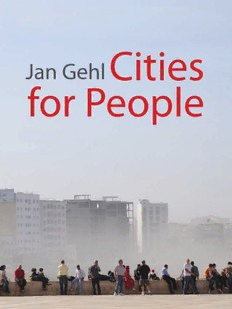
Cities for People PDF
Preview Cities for People
Cities for people I II Cities for people Jan Gehl Washington l Covelo l London III Copyright © 2010 Jan Gehl All rights reserved under International and Pan-American Copyright Con- ventions. No part of this book may be reproduced in any form or by any means without permission in writing from the publisher: Island Press, 1718 Connecticut Ave., NW, Suite 300, Washington, DC 20009. ISLAND PRESS is a trademark of The Center for Resource Economics. Gehl, Jan, 1936- Cities for people / Jan Gehl. p. cm. Includes bibliographical references and index. ISBN-13: 978-1-59726-573-7 (cloth : alk. paper) ISBN-10: 1-59726-573-X (cloth : alk. paper) ISBN-13: 978-1-59726-574-4 (pbk. : alk. paper) ISBN-10: 1-59726-574-8 (pbk. : alk. paper) 1. City planning. 2. City and town life. 3. City planning--Environmental aspects. I. Title. HT166.G438 2010 307.1‘216--dc22 2010015763 Printed on recycled, acid-free paper Project team Birgitte Bundesen Svarre, project manager Isabel Duckett, design and layout Camilla Richter-Friis van Deurs, illustrations and cover design Louise Kielgast, project assistant Rikke Sode, project assistant Andrea Have, photo assistant Karen Ann Steenhard, translation PJ Schmidt, photo editing Cover: Waterfront, Casablanca, Morocco, photo, Lars Gemzøe, 2009 This project was made possible with the financial support of the Realdania Foundation, Copenhagen. IV “Above all, do not lose your desire to walk. Every day I walk myself into a state of well-being and walk away from every illness. I have walked myself into my best thoughts, and I know of no thought so burden- some that one cannot walk away from it.“ Søren Aabye Kierkegaard Danish philosopher 1813-1855 Contents IX Foreword and preface IX Foreword by Richard Rogers X Preface by the author 1 1. The human dimension 3 1.1 The human dimension 9 1.2 First we shape the cities – then they shape us 19 1.3 The city as meeting place 31 2. Senses and scale 33 2.1 Senses and scale 47 2.2 Senses and communication 55 2.3 The shattered scale 61 3. The lively, safe, sustainable, and healthy city 63 3.1 The lively city 91 3.2 The safe city 105 3.3 The sustainable city 111 3.4 The healthy city VI 1 17 4. The city at eye level 118 4.1 The battle for quality is on the small scale 119 4.2 Good cities for walking 134 4.3 Good cities for staying 148 4.4 Good cities for meeting 158 4.5 Self-expression, play, and exercise 162 4.6 Good places, fine scale 168 4.7 Good weather at eye level, please 176 4.8 Beautiful cities, good experiences 182 4.9 Good cities for bicycling 1 93 5. Life, space, buildings — in that order 195 5.1 The Brazília Syndrome 198 5.2 Life, space, buildings — in that order 2 13 6. Developing cities 215 6.1 Developing cities 229 6.2 The human dimension — a universal starting point 2 31 Toolbox 2 47 Appendix 248 Notes 255 Bibliography 260 Illustrations and photos 261 Index VII VIII Foreword by Richard Rogers Cities are the places where people meet to exchange ideas, trade, or simply relax and enjoy themselves. A city‘s public domain — its streets, squares, and parks — is the stage and the catalyst for these activities. Jan Gehl, the doyen of public-space design, has a deep understanding of how we use the public domain and offers us the tools we need to improve the design of public spaces and, as a consequence, the quality of our lives in cities. The compact city — with development grouped around public transport, walking, and cycling — is the only environmentally sustaina- ble form of city. However, for population densities to increase and for walking and cycling to be widespread, a city must increase the quantity and quality of well-planned beautiful public spaces that are human in scale, sustainable, healthy, safe, and lively. Cities — like books — can be read, and Jan Gehl understands their language. The street, the footpath, the square, and the park are the grammar of the city; they provide the structure that enables cities to come to life, and to encourage and accommodate diverse activities, from the quiet and contemplative to the noisy and busy. A humane city — with carefully designed streets, squares, and parks — creates plea- sure for visitors and passers-by, as well as for those who live, work, and play there every day. Everyone should have the right to easily accessible open spaces, just as they have a right to clean water. Everyone should be able to see a tree from their window, or to sit on a bench close to their home with a play space for children, or to walk to a park within ten minutes. Well-desig- ned neighborhoods inspire the people who live in them, whilst poorly designed cities brutalize their citizens. As Jan says: “We shape cities, and they shape us.” No one has examined the morphology and use of public space to the extent that Jan Gehl has. Anyone who reads this book will get a valuable insight into his astonishingly perceptive understanding of the relations- hip between public spaces and civic society, and how the two are inex- tricably intertwined. London, February 2010 Richard Rogers Baron Rogers of Riverside CH, Kt, FRIBA, FCSD IX
